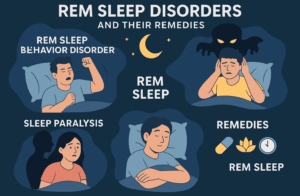REM Sleep Disorders and Their Remedies: Understanding and Treating Sleep Gone Wrong
 🌙 What is REM Sleep?
🌙 What is REM Sleep?
REM (Rapid Eye Movement) sleep is the stage of sleep where dreaming occurs. It is essential for memory consolidation, emotional processing, and brain repair.
Each night, we cycle through:
-
Non-REM sleep (light and deep sleep)
-
REM sleep, usually starting 90 minutes after sleep onset and recurring every 90–120 minutes.
In REM sleep:
-
The brain is active
-
The body is supposed to be paralyzed (muscle atonia) to prevent acting out dreams
-
The mind processes emotions and memory
When this system fails, REM sleep disorders can occur.
🧠 Types of REM Sleep Disorders
1. REM Sleep Behavior Disorder (RBD)
-
Acting out dreams: kicking, shouting, punching
-
Can result in injury to self or bed partner
-
Common in men over 50
-
Strongly associated with Parkinson’s disease or Lewy Body Dementia
2. Nightmare Disorder
-
Frequent, distressing dreams that cause awakening and distress
-
Vivid recall of the dream
-
Can occur due to stress, PTSD, antidepressant use, or withdrawal
3. Sleep Paralysis
-
Temporary inability to move while falling asleep or waking up
-
Often accompanied by hallucinations
-
Benign, but can be terrifying
4. Narcolepsy (with REM Dysregulation)
-
REM intrudes into wakefulness
-
Symptoms include cataplexy (sudden muscle loss), hallucinations, and sleep paralysis
-
Caused by hypocretin deficiency in the brain
🔍 How are REM Sleep Disorders Diagnosed?
-
Sleep history and symptom diary
-
Polysomnography (overnight sleep study) – to assess sleep architecture and muscle activity
-
Video EEG if seizures are suspected
-
MRI and neuropsychological evaluation if linked to neurodegeneration
✅ Remedies and Treatment Options
🩺 For REM Sleep Behavior Disorder (RBD)
-
Clonazepam (0.5–1 mg at bedtime) – gold standard treatment
-
Melatonin (3–12 mg/night) – safer alternative, fewer side effects
-
Safe sleep environment: remove sharp objects, use padding
-
Rule out underlying neurodegenerative diseases
💭 For Nightmare Disorder
-
Imagery Rehearsal Therapy (IRT): visualize a new ending to the dream during the day
-
CBT-I (Cognitive Behavioral Therapy for Insomnia): reduce fear of sleep
-
Prazosin (especially in PTSD-related nightmares)
-
Taper offending drugs (e.g., SSRIs or withdrawal from alcohol/benzos)
🧘 For Sleep Paralysis
-
Reassurance: it is not dangerous
-
Improve sleep hygiene and regularity
-
Consider antidepressants like fluoxetine if recurrent
-
Stress management and relaxation techniques
🧠 For Narcolepsy
-
Modafinil or solriamfetol for daytime sleepiness
-
Sodium oxybate for cataplexy and REM suppression
-
Structured naps and stimulant control
-
Referral to a sleep specialist
🌿 Lifestyle and Behavioral Remedies
-
Keep a consistent sleep-wake schedule
-
Avoid alcohol, heavy meals, and screens before bed
-
Practice meditation, yoga, or progressive muscle relaxation
-
Keep a dream diary to observe patterns and track progress
🧭 When to Seek Help?
Consult a psychiatrist or sleep specialist if you:
-
Act out your dreams or wake up with injuries
-
Have frequent nightmares disrupting your mood or functioning
-
Experience hallucinations or sleep paralysis frequently
-
Feel excessively sleepy during the day despite enough rest
✨ Final Thoughts: Your Sleep Can Be Saved
REM sleep is like the brain’s emotional detox. When it’s disrupted, your mind doesn’t get the rest it needs. But with the right diagnosis and treatment, REM sleep disorders are manageable and often reversible.
📍 Dr. T. Srinivas Rajkumar
Consultant Psychiatrist – Sleep, Anxiety & Neuropsychiatry
🕓 Available at Apollo Clinics, Velachery & Tambaram
📞 8595155808 | 🌐 www.srinivasaiims.com